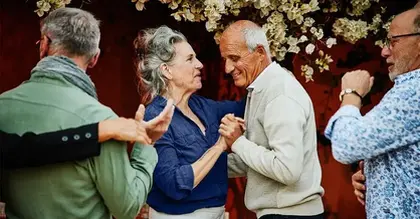
- Researchers are reporting that having stronger quadricep muscles may help lower a person’s risk of having knee replacement surgery.
- They explain that stronger muscles in the thigh can help stabilize the knee joint and reduce pressure on it.
- Experts say running, cycling, weightlifting, and yoga are among the ways to strengthen leg muscles.
Weightlifters have a mantra about “leg days.” Don’t skip them.
The authors of a new study would likely agree. They say having stronger quadriceps – those big muscles around the front of the thighs – relative to the hamstrings may lower the risk of total knee replacement.
The research was recently presented at the annual meeting of the Radiological Society of North America (RSNA).
The scientists say their findings, which haven’t been published yet in a peer-reviewed journal, could help with strength-training programs for people with advanced arthritis in the knee.
The authors said in a statement that advanced knee osteoarthritis is a major cause of pain and disability worldwide. In the United States, an estimated
Although stronger muscle groups are generally believed to be associated with a lower rate of total knee replacement, their relative importance is not well established, the study authors said.
They added that of particular interest is the relationship between the extensors and the hamstrings, which are the two most important muscle groups in the knee.
The extensors are the muscles on the front of the thigh, also known as the quadriceps. They’re one of the body’s strongest muscle groups and have an essential influence on gait, biomechanics, and other activities.
The muscles around the back of the thigh are the hamstrings, which are responsible for extension of the hip and flexion of the knee, making them equally essential for physical activity.
“The two muscle groups act as counter forces, and the balance between them enables a wide range of activities while protecting the knee joint,” said Dr. Upasana Upadhyay Bharadwaj, a post-doctoral scholar in radiation at the University of California, San Francisco and the study’s lead author, in the statement. “An imbalance, in addition to other factors, leads to a change in the biomechanics resulting in the progression of osteoarthritis.”
Upadhyay Bharadwaj’s team evaluated thigh muscle volume in 134 participants from the
The researchers compared 67 people who had total knee replacement in a single knee with 67 control participants who still had their original knees. Cases and controls were matched for variables such as age and gender.
The researchers compared MRIs of the thigh at the time of surgery as well as two years before and four years before. They also used a deep-learning model to segment and compute volumes of the thigh muscles.
Comparing participants who underwent total knee replacement with the control group, the researchers reported that a higher ratio of quadriceps to hamstring volume significantly showed lower odds of total knee replacement.
Higher volumes of hamstrings and gracilis, a long, thin muscle on the inside of the thigh, were also linked with lower odds of total knee replacement.
“Our study shows that in addition to strong muscles individually, larger extensor muscle groups — relative to hamstring muscle groups — are significantly associated with lower odds of total knee replacement surgery in two to four years,” Upadhyay Bharadwaj said.
The researchers said their findings have implications for the interpretation of imaging exams and clinical management.
They said the results suggest training programs to strengthen the quadriceps in relation to the hamstrings may be beneficial.
“Although we presume that overall muscle volume is important as a surrogate marker for muscle strength, the ratio, hence the balance, between extensor and hamstring muscles may be more important and significantly associated with lower odds of total knee replacement,” Upadhyay Bharadwaj said.
Although the study focused on people with arthritis, the results could help inform strength training for a wider segment of the population.
“While these results are essential for targeted therapy in a population at risk for osteoarthritis, even the general public can benefit from our results to preventively incorporate appropriate strengthening exercises,” Upadhyay Bharadwaj said.
Dr. Timothy Gibson, an orthopedic surgeon and medical director of the MemorialCare Joint Replacement Center at Orange Coast Medical Center in California who was not involved in the study, told Medical News Today it’s already understood strong quadriceps muscles can delay knee replacement surgery or help symptoms of an arthritic knee.
“The idea that the ratio of the extensor muscles to the hamstring muscle is important may be new,” Gibson said. “It is an interesting study. However, in clinical practice, it may not change current treatment recommendations. I have recommended for years to my patients with knee arthritis to work hard on quadricep strength since they act as shock absorbers to control forces across the knee with each step, especially with stair climbing.”
Gibson added that the quadriceps starts as a muscle in the thigh bone and crosses over the front part of the knee and connects shin bone (tibia) via the patella and patellar tendon.
“It is a strong extensor of the knee,” Gibson said. “More importantly it controls eccentric muscle contraction with weight-bearing or ascending/descending stairs. With a strong quadriceps, the force across the knee is distributed more evenly and in a more controlled manner which helped reduce pain with each step.”
Gibson said, other than weight loss, quadricep strength is the most important nonoperative treatment in people with knee arthritis.
“It makes them more mobile and less likely to fall,” he said. “It can really help with pain and prolong the period of time in which surgery can be delayed.
Dr. Steve Yoon, a physiatrist and director of The Regenerative Sports and Joint Clinic at Cedars-Sinai Kerlan-Jobe Institute in Los Angeles who was not involved in the study, told Medical News Today that stabilization of the knee joint and decreasing its load with movement and activity can help decrease the degradation of the tissues within the joint such as cartilage and the menisci.
“Studies like this emphasize that strength can have an overall impact with the degradation of a joint,” Yoon said. “It’s a reminder that everyone can play a role in their overall joint health. For some people, this will change the way they exercise and perhaps encourage incorporating leg strength training into their exercise routine.”
Dr. Jules David Hip-Flores, an orthopedic surgeon for Northwell Health in Staten Island, New York, who was not involved in the study told Medical News Today that strengthening the muscles around a joint provides dynamic stabilization.
“The quad muscles work to extend the knee and stabilize the patellofemoral articulation of the knee,” Hip-Flores said. “Additionally, they are very important in ADLs (activities of daily living) such as getting up from a chair and walking up a staircase.”
“I don’t know if it will change how people train their legs, but it’s more evidence that strength training is an important part of staying healthy as we age,” he added.
Joe Bloom, is the founder of MMA Hive, a platform dedicated to martial arts, fitness, and overall well-being. Bloom told Medical News Today quads are often a focus due to their visibility and overall importance for lower-body strength, “this research highlights the need for a balanced ratio between quads and hamstrings — whereas before it’s been quad-heavy programming.”
“It seems clearer that having relative strength in other leg muscles, like the hamstrings, will lead to better outcomes and reduce joint issues or knee replacements,” Bloom said. “As any great fitness trainer will tell you, it’s always about balance across the whole body through functional training.”
Gibson said there are ways to train quads and hamstrings that people of all ages can do.
“Strengthening can be performed by cycling, weight training, wall slides, Pilates, yoga and numerous other activities,” Gibson said. “Believe it or not, quad strengthening is often neglected as part of the nonsurgical treatment of knee arthritis.”
“People become sedentary, and do not realize that they become weak unwittingly just by favoring the painful knee,” he added. “They worry that exercise and strengthening may cause more pain. In fact, it helps the pain. This study may help to refocus attention to the importance of this treatment option in this common problem.”





